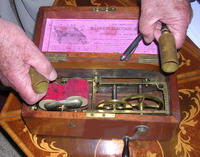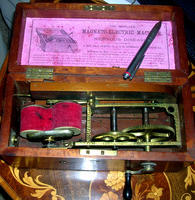
South Australian Medical Heritage Society Inc
Website for the Virtual Museum
Home
Coming meetings
Past meetings
About the Society
Main Galleries
Medicine
Surgery
Anaesthesia
X-rays
Hospitals,other organisations
Individuals of note
Small Galleries
Ethnic medicine
- Aboriginal
- Chinese
- Mediterran
Electro-Magnetic Machines
Acknowledgements:
We are grateful to Dr. P. M. Last, who demonstrated and provided an opportunity to photograph
this machine. The apparatus was originally owned by Dr. H. C. F. Esau MD (Göttingen), the first
general practioner in Woodside.
A short time after Michael Faraday (1831) showed that changing magnetic fields will induce an electric current in a neighbouring wire, numerous types of electromagnetic machines were developed. They were used not only in parlour demonstrations, but also in the treatment of some medical conditions.
The machine has a horseshoe permanent magnet, and two bobbins wound with wire rotated by a system of sprockets. They had a wide range of medical uses, and were popular in the latter part of the 19th century.
Their uses were directed at a wide range of conditions such as neurasthenia, toothache, and chronic fatigue syndromes. Reports in refereed medical journals were not supportive and the American FDA attempted to ban them in 1972, and they are no longer in use. Physiotherapists now however use much more sophisticated apparatus which produce deep heat either by radio short waves or therapeutic ultrasound.
The machine with the magnet, rotating coils and the hand driven geared up sprockets and a final pulley drive. An increase in rotating speed produced sensations ranging from tingling to an electric shock.
School boy's "Electrical sets" in the first part of the 20th century often included "Shocking Coils" run off a dry battery using a "make and break" actuated by the magnetism produced by a primary coil which induced a higher voltage in the multiple windings of the surrounding secondary coil, connected to the handles. These were only for domestic fun, or to demonstrate the principle of an induction coil.


